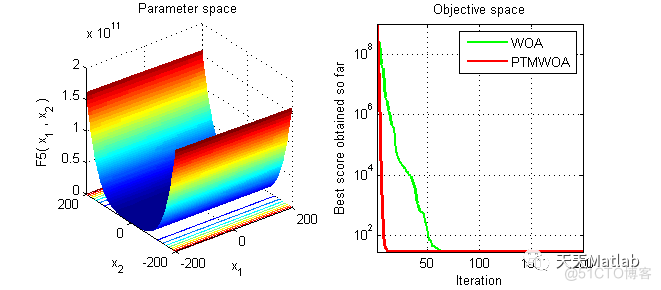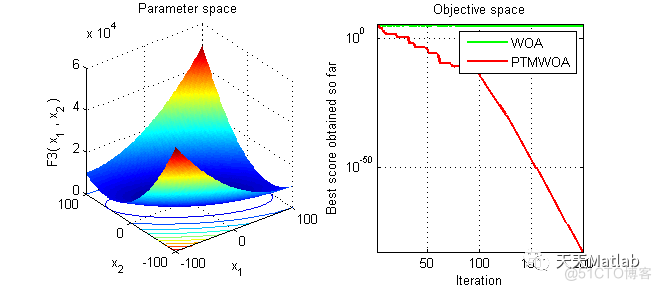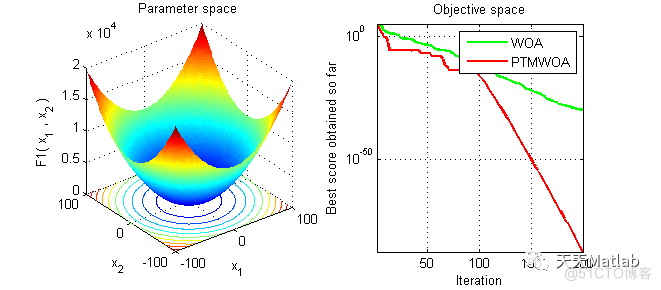✅作者简介:热爱科研的Matlab仿真开发者,修心和技术同步精进,matlab项目合作可私信。
🍎个人主页:Matlab科研工作室
🍊个人信条:格物致知。
⛄ 内容介绍
针对基本鲸鱼优化算法在非线性优化问题中存在的收敛精度低,易陷入局部最优解的问题,提出一种融合动态概率阈值和自适应变异的鲸鱼优化算法.首先,利用Fuch混沌和反向学习生成均匀的初始种群;其次,设计基于双曲余弦函数的动态调整概率阈值以协调算法全局搜索与局部开采能力,采用可变权重对鲸鱼位置更新公式修正,提高收敛速度和精度;最后,对鲸鱼精英个体引入自适应变异策略,以避免算法陷入局部最优解而搜索停滞.对13个基准测试函数仿真实验,结果表明,与基本GWO算法,PSO算法以及鲸鱼优化算法相比,该算法具有更好的求解精度,收敛速度.
⛄ 部分代码
%_________________________________________________________________________%
% 鲸鱼优化算法 %
%_________________________________________________________________________%
% The Whale Optimization Algorithm
function [Leader_score,Leader_pos,Convergence_curve]=WOA(SearchAgents_no,Max_iter,lb,ub,dim,fobj)
% initialize position vector and score for the leader
Leader_pos=zeros(1,dim);
Leader_score=inf; %change this to -inf for maximization problems
%Initialize the positions of search agents
Positions=initialization(SearchAgents_no,dim,ub,lb);
Convergence_curve=zeros(1,Max_iter);
t=0;% Loop counter
% Main loop
while t<Max_iter
for i=1:size(Positions,1)
% Return back the search agents that go beyond the boundaries of the search space
Flag4ub=Positions(i,:)>ub;
Flag4lb=Positions(i,:)<lb;
Positions(i,:)=(Positions(i,:).*(~(Flag4ub+Flag4lb)))+ub.*Flag4ub+lb.*Flag4lb;
% Calculate objective function for each search agent
fitness=fobj(Positions(i,:));
% Update the leader
if fitness<Leader_score % Change this to > for maximization problem
Leader_score=fitness; % Update alpha
Leader_pos=Positions(i,:);
end
end
a=2-t*((2)/Max_iter); % a decreases linearly fron 2 to 0 in Eq. (2.3)
% a2 linearly dicreases from -1 to -2 to calculate t in Eq. (3.12)
a2=-1+t*((-1)/Max_iter);
% Update the Position of search agents
for i=1:size(Positions,1)
r1=rand(); % r1 is a random number in [0,1]
r2=rand(); % r2 is a random number in [0,1]
A=2*a*r1-a; % Eq. (2.3) in the paper
C=2*r2; % Eq. (2.4) in the paper
b=1; % parameters in Eq. (2.5)
l=(a2-1)*rand+1; % parameters in Eq. (2.5)
p = rand(); % p in Eq. (2.6)
for j=1:size(Positions,2)
if p<0.5
if abs(A)>=1
rand_leader_index = floor(SearchAgents_no*rand()+1);
X_rand = Positions(rand_leader_index, :);
D_X_rand=abs(C*X_rand(j)-Positions(i,j)); % Eq. (2.7)
Positions(i,j)=X_rand(j)-A*D_X_rand; % Eq. (2.8)
elseif abs(A)<1
D_Leader=abs(C*Leader_pos(j)-Positions(i,j)); % Eq. (2.1)
Positions(i,j)=Leader_pos(j)-A*D_Leader; % Eq. (2.2)
end
elseif p>=0.5
distance2Leader=abs(Leader_pos(j)-Positions(i,j));
% Eq. (2.5)
Positions(i,j)=distance2Leader*exp(b.*l).*cos(l.*2*pi)+Leader_pos(j);
end
end
end
t=t+1;
Convergence_curve(t)=Leader_score;
end
⛄ 运行结果



⛄ 参考文献
[1]毕孝儒, 牟琦, 龚尚福. 融合动态概率阈值和自适应变异的鲸鱼优化算法[J]. 微电子学与计算机, 2019, 36(12):7.




 文章提出了一种融合动态概率阈值和自适应变异的鲸鱼优化算法,旨在解决基本鲸鱼优化算法在非线性优化问题中收敛精度低和易陷入局部最优解的问题。通过Fuch混沌和反向学习生成初始种群,使用双曲余弦函数动态调整概率阈值,结合可变权重修正位置更新公式,同时引入自适应变异策略防止算法停滞于局部最优。仿真实验显示,该算法在求解精度和收敛速度上优于基本的GWO算法和PSO算法。
文章提出了一种融合动态概率阈值和自适应变异的鲸鱼优化算法,旨在解决基本鲸鱼优化算法在非线性优化问题中收敛精度低和易陷入局部最优解的问题。通过Fuch混沌和反向学习生成初始种群,使用双曲余弦函数动态调整概率阈值,结合可变权重修正位置更新公式,同时引入自适应变异策略防止算法停滞于局部最优。仿真实验显示,该算法在求解精度和收敛速度上优于基本的GWO算法和PSO算法。
















 249
249

 被折叠的 条评论
为什么被折叠?
被折叠的 条评论
为什么被折叠?








